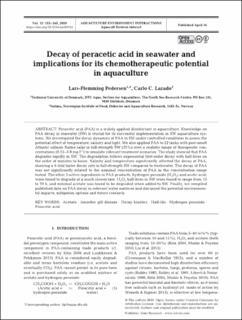| dc.contributor.author | Pedersen, Lars-Flemming | |
| dc.contributor.author | Lazado, Carlo C. | |
| dc.date.accessioned | 2020-09-17T12:17:27Z | |
| dc.date.available | 2020-09-17T12:17:27Z | |
| dc.date.created | 2020-02-18T17:48:27Z | |
| dc.date.issued | 2020 | |
| dc.identifier.citation | Aquaculture Environment Interactions. 2020, 12 153-165. | |
| dc.identifier.issn | 1869-215X | |
| dc.identifier.uri | https://hdl.handle.net/11250/2678286 | |
| dc.description.abstract | Peracetic acid (PAA) is a widely applied disinfectant in aquaculture. Knowledge on PAA decay in seawater (SW) is crucial for its potential successful implementation in SW aquaculture productions systems. Furthermore, residual decay of PAA is likely to have practical implications on developing effective treatment protocols by taking into account target efficacy and fish physiological responses to PAA in SW. We investigated the decay dynamics of PAA in SW under controlled conditions to assess the potential effect of temperature, salinity and light. We also applied PAA to 22 tanks with Atlantic salmon (Salmo salar) post-smolt in full-strength SW (33 ‰) over a realistic range of therapeutic concentrations (0.15-4.8 mg l-1) to simulate relevant treatment scenarios. The study showed that PAA degrades rapidly in saltwater. The degradation follows exponential first-order decay with half-lives in the order of minutes to hours. Salinity and temperature significantly increased degradation of PAA, showing a four-fold faster degradation in full-strength seawater compared to freshwater. The decay of PAA was not significantly related to the nominal concentration of PAA in the concentration range tested. The other two active ingredients in PAA products, hydrogen peroxide (H2O2) and acetic acid were found to degrade at a much slower rate. H2O2 half-lives in SW were found to range from 15 to 70 h and minimal acetate degradation in clean SW was found. Finally, we compiled published data on PAA decay in relevant water matrices and discussed the potential environmental impacts, mitigation options and future research. | |
| dc.language.iso | eng | |
| dc.title | Decay of peracetic acid in seawater and implications for its chemotherapeutic potential in aquaculture | |
| dc.type | Peer reviewed | |
| dc.type | Journal article | |
| dc.description.version | publishedVersion | |
| dc.source.pagenumber | 153-165 | |
| dc.source.volume | 12 | |
| dc.source.journal | Aquaculture Environment Interactions | |
| dc.identifier.doi | 10.3354/aei00354 | |
| dc.identifier.cristin | 1795599 | |
| cristin.ispublished | true | |
| cristin.fulltext | original | |
| cristin.qualitycode | 1 | |
